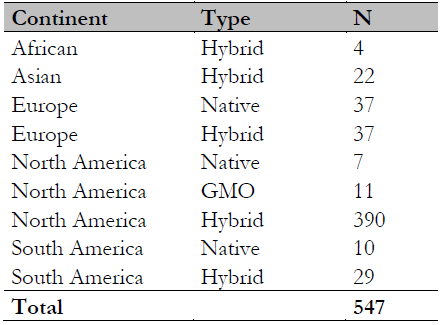Introduction
Corn, Zea mays L. (Poaceae) silage is the most widely used energy resource in the diets of dairy cattle worldwide (Leonhart & Beneitez, 2019). This energy comes from the starch in the grain fraction (Fernández, 2014), which is the primary source of metabolizable energy in corn silage and considered an important characteristic (Khan et al., 2015). Corn silage stands out for its higher biomass yields, good palatability (Hidalgo et al., 2018; Mandić et al., 2018), homogeneous quality at harvest, and ease of silage due to the higher soluble sugar content (Ali et al., 2019) compared to other grasses. It is worth noting that parameters such as crude protein (CP), neutral detergent fiber (NDF), and neutral detergent fiber digestibility (NDFD) (Combs, 2015) should be considered, as well as fast growth and resistance to foliar diseases (Rivas et al., 2018; Sánchez et al., 2019), characteristics related to the ideal idiotype of forage corn (Bertoia, 2015).
The corn crop has a constant yield under various environmental and agronomic conditions (Khan et al., 2015);. However, the nutritional quality depends on many factors, such as genotype, plant density, growth conditions, maturity, and humidity of the crop at harvest (Mandic et al., 2018). Increasing forage productivity in dry matter (DM) without decreasing the quality is a determining factor for efficient milk production (Zaragoza et al., 2019). Currently, the hybrids commercialized were intended for grain production and placed on the market for their biomass production without considering the nutritional quality of DM and its digestibility (Rivas et al., 2018).
The MILK2006® program (Shaver et al., 2006) allows the evaluation of nutritional components of forage and the estimation of milk production per ton of DM. It makes it possible by using a forage energy value predicted from the Acid Detergent Fiber (ADF) content and the potential intake of DM, based on the Neutral Detergent Fiber (NDF) content and digestibility. This milk quality index has become a focal point for silage evaluation (Shaver et al., 2006).
The genetic improvement of corn silage raises the need to identify germplasm sources and takes advantage of the existing genetics (Rivas et al., 2018), identifying varieties with productive capacity and nutritional quality (Zaragoza et al., 2019). This study aims to review studies on the quality and yield of corn silage in different regions around the world using the program MILK2006® and estimate milk production per ton of DM to characterize nutritional quality, forage yield, and potential milk production of silages worldwide. The hypothesis of the present study is that the quality and yield of corn silage in different countries are similar according to their chemical composition and fodder yield and consequently their milk production potential per hectare.
Material and methods
Data collection
The search was confirmed by the compressed and structured review of studies on the quality and yield of corn silage in different regions worldwide. The publications were obtained from Google Scholar, Redalyc, Elsevier, SCOPUS, and Web of Science databases. The total number of scientific articles selected for the systematic review was 52. Figure 1 shows the PRISMA flowchart of the systematic review from the initial search and screening to the final selection of publications.
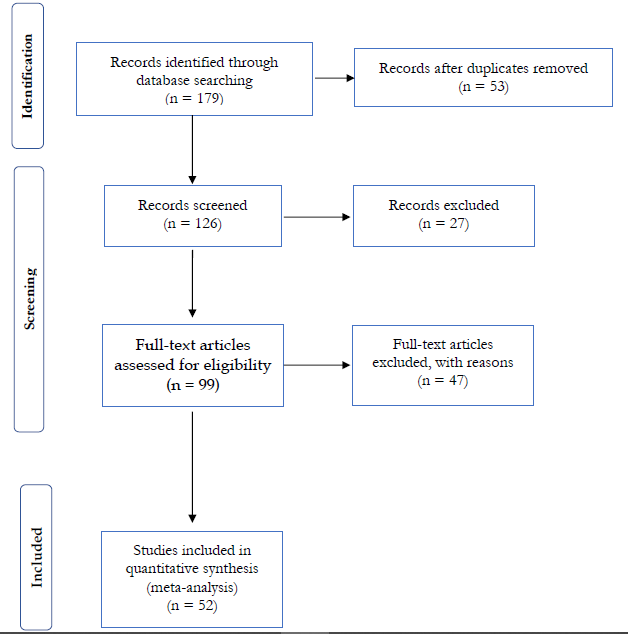
Source: Elaborated by the authors based on Moher et al., 2009.
Figure 1. PRISMA flowchart from the initial search and screening to the final selection of publications to be included in the meta-analysis.
Inclusion criteria
We study agronomic data and nutritional variables, such as DM yield (t/ha), planting density (number of plants/ha), quantity of DM, Crude Protein (CP), Neutral Detergent Fiber (NDF), Non-Fibrous Carbohydrates (NFC), Organic Matter (OM), DM Digestibility (DMD), and Neutral Detergent Fiber Digestibility (NDFD).
Calculations
Missing data for starch and ether extract (EE) in those studies that did not contain this information were calculated according to the National Research Council (NRC, 2001). Net energy for lactation (NEL, MJ/kg DM), total digestible nutrients (TDN), kilograms of milk per ton of DM (kg milk/t DM), and kilograms of milk per hectare (kg milk/ha) were calculated using the MILK2006® program (Shaver et al., 2006). The estimated value of EE was adjusted to the milk yield according to the fat content of the milk to reflect the concentration of its relative energy, thus reflecting the amount of energy required to produce the estimated amount of milk.
In the model, milk production is estimated from a cow with a live weight of 612 kg, fed with 300 g/kg of NDF with corn silage as the only forage and producing 35 g/kg of milk (kg/day) (Shaver et al., 2006). The missing values for NDFD were calculated using a regression equation with the data obtained from the registered papers that contained this information (Equation 1):
Like TDN, milk production was estimated using the MILK2006® model (Shaver et al., 2006).
Database
The database comprised 547 journals published and found in five regions (Africa: n = 4, Asia: n = 22, Europe: n = 74, North America: n = 408, and South America: n = 39), as well as the information sources by region and genetic line of the corn (Table 1). Fifteen variables related to DM production, planting density, and nutritional characteristics were considered (Table 2).
Statistical analysis
The variables were analyzed in two independent stages: an analysis of the interrelationships between the 15 variables (multivariate analysis) and then a factorial analysis (PROC FACTOR, SAS Institute INC., 2007) (SAS, 2007) to estimate their contribution to the total variance.
The information sources were grouped in homogeneous levels through the analysis of Ward’s hierarchical clustering method (PROC CLUSTER, SAS Institute INC., 2007) (SAS, 2007) using the selected variables. Five hundred and forty-seven observations of corn silage were evaluated to know which group of variables correlated with each other, obtaining six clusters. According to integrated groups, an ANDEVA was performed between the six levels (P < 0.05). Tukey’s test (SAS, 2007) was used to determine the differences between the groups formed (multiple comparisons of means), while Pearson’s correlation analysis was performed to determine the relationship between the variables.
Results and discussion
Eigthy-two percent of the 547 observations shown in Table 1 were from the American continent (75% from North America, 7% from South America), and 13% from Europe. These observations met the search requirements shown in Table 2.
Table 2. Variables considered for the meta-analysis of corn silage globally
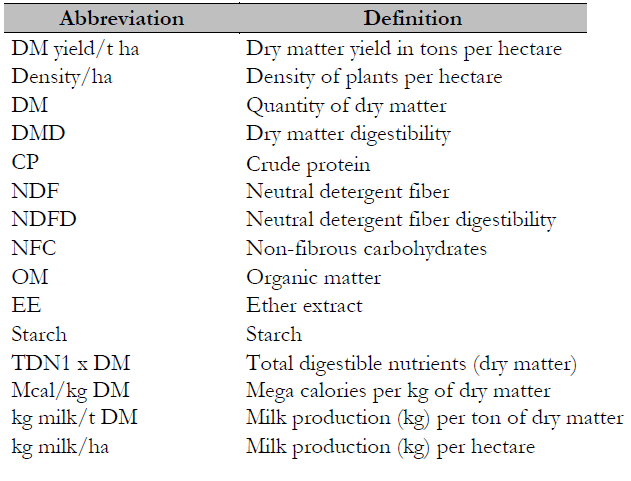
Source: Elaborated by the authors
Worldwide, the leading corn producers are the United States (USA), China, and Brazil (Santana et al., 2018). However, its use as a fodder source for cattle feed occurs in North America, South America, and Europe (Sánchez & Hidalgo, 2018). Table 1 shows a relationship with Bernardes et al.’s (2018) statements: most observations are from North America and Europe since silage production is more developed in temperate zones. For the observations on the type of corn used we can define two criteria or slopes. The first one is based on the legislation on the use of genetically modified crops in European and Asian countries. The second one is based on the criterion that GMO foods do not differ significantly in production and quality from conventional ones. Endorsed by the US Food and Drug Administration (FDA), it is practiced in America, where 87% of the GMO surface is planted worldwide (Guerrero et al., 2018). Native varieties continue to be used for silage production because of their high growth rate and resistance to the climate and environment, while hybrids are of small contribution to producing little biomass due to their selection for a higher grain yield and not for their biomass yield (Sánchez et al., 2019).
Descriptive statistics for corn silage are shown in Table 3, where the global corn silage yield averages 15.70 tons of DM and an average population density of 76,155 plants per hectare. The average DM is 33.11 g/100 g DM, with digestibility of 63.68 g/100 g DM, CP of 7.8 g/100 g DM, and NDF of 49.74 g/100 g DM with digestibility of 60.48 g/100 g DM. While NFC ranges on average from 33.20 g/100 g DM, with OM of 94.16 g/100 g DM, 3.51 g/100 g DM for EE, and 23.39 g/100 g DM for starch. The average TDN is 66.66 g/100 g DM, with 1.41 Mcal/kg DM, producing 531.44 kg milk/t DM and 19,190.8 kg milk/ha.
Table 3. Average, standard deviation, and minimum and maximum values of the variables analyzed. The chemical composition is expressed in g/100 g of DM
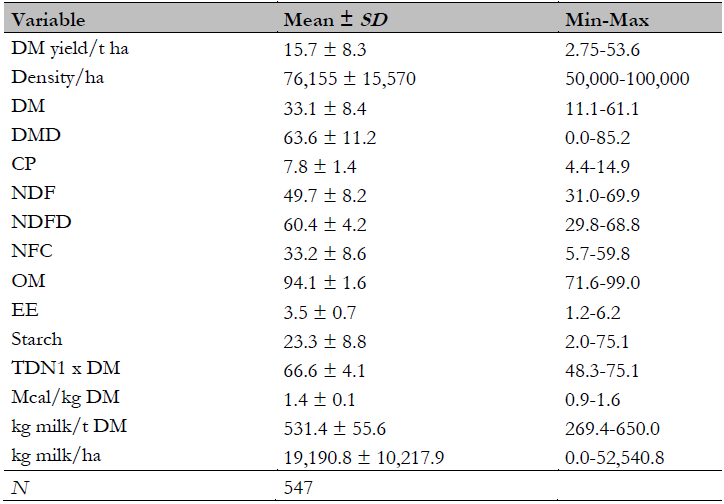
Source: Elaborated by the authors
The influence of whole plant maize yield by population density can be observed in Table 3, finding an average value between the highest population density and traditional density (Guacapiña et al., 2018); a higher density of plants/ha positively affects the production of a ton of DM/ha, with a higher production of Fresh Matter (FM) (Camarasa et al., 2019). Guacapiña et al. (2018) found that increasing planting densities increases the amount of DM and FM, without modifying the silage quality (NDF and digestibility). The average of number of plants/ha agrees with the amount of DM in silage (Zaragoza et al., 2019), obtaining a better nutritional quality and a higher DM yield.
A large amount of DM causes difficulty in compacting, and the retained air causes heating in the silage material and quality losses (Vanegas & Codero, 2019). Guyader et al. (2018) indicated that silage material with high humidity (< 28 g/100 g DM) would cause increased filtration in the silo and reduce DM intake, while material that is too dry (> 40 g/100 g DM) is difficult to compact, and the oxygen present will produce poor fermentation in the silo.
The DMD of high-quality forage is around 70 g/100 g DM of in vitro DM digestibility (Cardozo, 2013). The DMD in the present study is below the parameters described in the meta-analysis of Ferraretto and Shaver (2012b), from 66.3 to 69.1 g/100 g DM, but within the range of 52-68 g/100 g DM described by Chaudhary et al. (2014), which may be related to an increase in the harvest stage. At advanced maturity, it decreases the in vitro digestibility of DM (Arriola et al., 2012). The CP concentration is between 8 and 11 g/100 g DM (Chaudhary et al., 2014), placing the average value below the established range, although the protein content can vary between 5.2 and 7.5 g/100 g DM, considering that for good forage, the CP should be higher than 7 g/100 g DM (Ali et al., 2019).
The NDF reported by Calsamiglia et al. (2004) is between 44.9 and 57.0 g/100 g DM, where the average value of silage is within this range, considering that a quality forage has an NDF less than 50 g/100 g DM (Ali et al., 2019). At the same time, NDFD is higher than that described by Ferraretto and Shaver (2012b), with a content of 42.4 to 48.9 g/100 g DM. However, although a higher NDFD is desirable, it can reduce the digestibility of starch through an increase in the rate of passage of starch in the gastrointestinal tract (Ferraretto & Shaver, 2015). The NFC content is between 27 and 32 g/100g DM, allowing good fermentation (Vanegas & Codero, 2019); the average NFC in the meta-analysis is higher than 30 g/100g DM, characteristic of good quality forage (Ali et al., 2019). The OM is below the values mentioned by Calsamiglia et al. (2004) (95.82 g/100 g DM), representing a higher concentration of ashes, which in turn produces a decrease in NFC and in TDN values (Ferraretto & Shaver, 2015). The EE content is between 3.76 and 4.54 g/100 g DM, being the average value of EE in this study below this range (Martínez Turcios, 2017).
The starch content is between 10.3 and 34.2 g/100 g DM, where the average value is within the range but below the established DM amount (25 to 35 g/100 g DM), which should contain 28.0-31. 8 g/100 g DM of starch. The age of harvest influences starch content, as well as the sowing date or population density (Salama, 2019); as grains move towards advanced maturity, starch content increases (Guyader et al., 2018). However, the vitreous endosperm of the kernel also increases, generating grain hardness, and these dry grains are less susceptible to breakage during processing (Ferraretto et al., 2018).
The range of TDN is between 55 and 78 g/100 g DM (Fernández, 2014); thus, the average value of this component is within the range. It is necessary to consider the adverse effects of the harvest; in advanced stages of maturity, they damage the utilization of the grain, reducing the TDN of more than 40 g/100 g DM described by Ferraretto and Shaver (2012b). The energy value depends on the amount of NFC, starch, and NDFD, giving a value of milk per ton of DM and milk per surface (Nestor, 2010). The milk yield increases with the advance of maturity, reaching an optimal level for corn silage with 30-40 g/100 g DM (Khan et al., 2015).
As observed in Table 4, derived from the analyzed variables and according to their proper values (eigenvalue), the first five factors emerged, which explained 81.56% of the total variance.
Table 4. Proper values and percentage of explained variance obtained in the factorial analysis of variables for corn silages worldwide
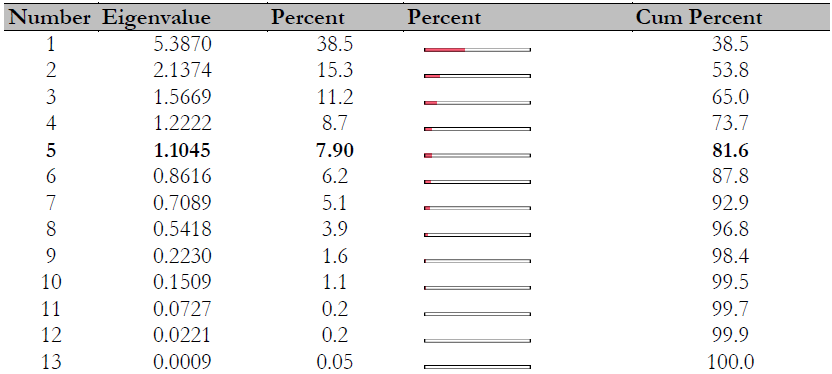
Source: Elaborated by the authors
The integration of the variables for each conformed factor is shown in Table 5. Factor 1 (F1) represented the highest degree of contribution to total variability (38.5%), composed of the variables related to TDN, Mcal/kg DM, NDF, NDFD, NFC, and starch. The variables of F2 corresponded to the Digestibility of DM and EE, including CP, DM, and EE, representing a substantial 15.3% of the total variance. The F3 comprises two variables: production in kilograms of milk per ha, and milk yield in tons DM per ha (kg milk/ha and milk yield/t ha), corresponding to 11.19% of the total variance. F4 comprises only one variable, NDF, accounting doe 8.7% of the total variance; and F5, OM, which makes up 7.9% of the total variance.
Table 5. Definition of factors, integration of variables, and percentage of total variance contributing to the total variance

Source: Elaborated by the authors
F1 explains most of the total variance of the present study (Tables 4, 5, and Figure 2) with the index of milk quality per ton of DM for corn silage, using an energy value derived from summative equations (NRC, 2001), and the DMI predicted from the NDF content and as a basis for the NDF. Also, it uses a maintenance summative energy equation TDN from NRC (2001) for corn silage, including starch and non-starch NFC, with a starch digestibility coefficient; the energy value NEL-3x is derived from maintenance TDN, using the empirical equation from National Research Council (NRC, 1988). Improved utilization of starch and NDFD can increase milk production (Ferraretto & Shaver, 2012a). Whole plant corn silages typically contain 30 g/100 g DM of starch and 40 g/100 g DM of NDF; an increase in starch or NDF can result in higher lactation performance by dairy cows (Ferraretto & Shaver, 2015). NDFD favors higher DMI (Guyader et al., 2018) and metabolizable energy (Vanegas & Codero, 2019); also, higher milk production is mainly related to higher DMI (Ferraretto & Shaver, 2015), which also has higher TDN compared to fodder with lower NDFD (Combs, 2015).
F2 is related to harvest maturity (HM) that alters yield, nutrient composition, digestibility, and crop silage potential; most changes are associated with core development, which alters the proportion of HM contributed by its various fractions. Generally, there is a higher proportion of grains and reduced proportion of stem and leaves (Ferraretto et al., 2018). The sugars in the grains are converted into starch, and the DM content of the grains increases (Guyader et al., 2018); a delay in the harvest of the whole plant produces a higher concentration of starch and a low decrease in the concentrations of CP, NDF, EE, and ashes (Amodu et al., 2014; Ferraretto et al., 2018). The CP concentration is similar among hybrid corn, suggesting that harvest recommendations are based on maturity, and may vary according to the hybrid being grown (Ferraretto et al., 2015). Ferraretto and Shaver (2012b) found a decrease in fat corrected milk yield (FCM, 3.5%) of 2.0 and 2.7 kg DM/cow per day on average, respectively, when the whole plant was harvested above 40 g/100g DM. Therefore, targeting 35 g/100 g DM at harvest is recommended to optimize the nutritional value of the whole plant and lactation yield in dairy cows (Ferraretto et al., 2018).
F3 shows the results of factors F1 and F2, where the harvest closest to grain maturity, within the DM window of 30 to 40 g/100 g DM, will have an adequate starch concentration and DM yield, as well as a higher NDFD and DMI, with the energy content of the whole plant (Guyader et al., 2018). Therefore, the optimal cutting time should be monitored to increase yield without decreasing its nutritional value (Vanegas & Codero, 2019).
For F4, the NDF concentration decreases typically with maturity due to the dilution effects of increasing starch concentration. Therefore, the high mean NDF concentration is consistent with the low mean starch concentration (Guyader et al., 2018). Delaying harvest time results in higher starch content in corn silage but compromises the NDF content, particularly the NDFD (Khan et al., 2015). DM, CP, and lignin contents increased with advanced maturity, but starch and NDF contents did not follow a pattern consistent with hybrid corn (Ferraretto & Shaver, 2015). In F5, ash content is used as an indirect method to estimate losses based on the assumption that as spoilage occurs, OM disappears, but the absolute amount of ash remains constant; ash content in the silage or silage core has small increases related to spoilage that represent percentage increases in the loss of OM (Borreani et al., 2018).
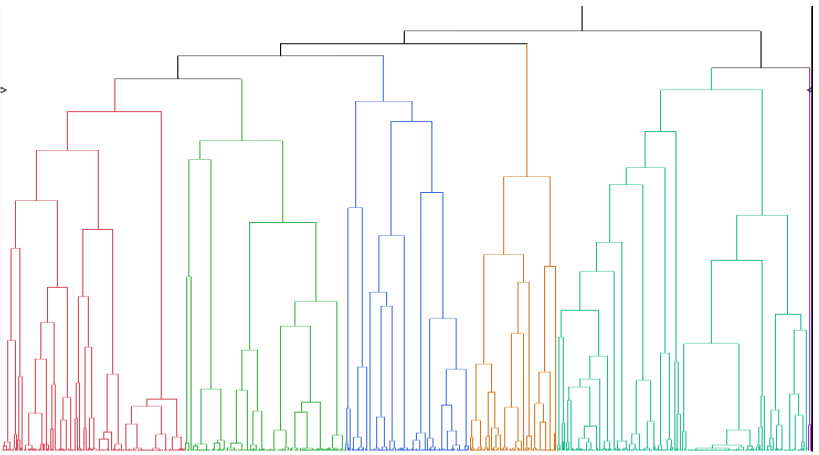
Figure 2. Hierarchical clusters obtained (dendrogram) from the cluster analysis of the variables, representing the grouping of the information sources. (CL1) called “Digestibility” (Red) because the associated variables were DMD, CP, NDFD, NEL, and kg milk t DM. The second (CL2), called “Density” (Green), was characterized by corn silage with higher density (number of plants/ha) and NDF%. In the third (CL3), called “Ash” (Blue), we can find those with the highest ash content. The fourth (CL4) was called “Average” (Orange) because it is made up of the average of all variables. The fifth (CL5), “Milk yield per ha” (Aqua), had the highest forage yield (DM yield/t ha) and kg milk/ha. The sixth (CL6), “kg milk/t” (Purple), had the greater DM, NDF, NEL digestibility (Mcal/kg DM), and kg milk/t DM.
According to the correlation analysis, the factors were finally integrated with their respective variables (Table 6), forming six CL: CL1 (123 observations), call “Starch,” includes its associated variables DMD, NDFD, TDN1xDM, Mcal/kg DM, and kg milk/t DM. CL2 (109 observations), called “EE,” was characterized by corn silage variables with the highest TDN1 x DM and Mega calories per kg of dry matter. CL3 (85 observations), called “DM,” has those with high NDFD content. In CL4 (59 observations), named “PD,” we can find a high yield of DM/ha and higher production of milk/ha. CL5 (169 observations) named “NDF” has the highest concentration of NDFD, and CL6 (2 observations) “CP” the higher content of CP.
CL1 “Starch” recorded the highest milk production (kg of milk/t DM) (Table 6), which was related to a higher concentration of Mcal/kg DM, influenced by its starch concentration, and of NFC, associated with DM yield. This association is due to one of the main factors that determine the nutritional quality of silage, which is the NDF content, resulting from the degree of maturity reached at the time of cutting, the corn variety (Khan et al., 2015), and the starch content in the plant (Ferraretto et al., 2015). In this group, we can assume the presence of early hybrid corn, with a higher DMD in vitro compared to intermediate or late cycle hybrids (Marchesini et al., 2019). Likewise, the early plants are smaller, with a higher production of cob and proportion of grain; this characteristic allows for a low NDF content (Nuñez et al., 2001; Peña et al., 2002) and phigh grain content, compared to late-maturing hybrids (Lynch et al., 2012). In other studies, we found corn from temperate climates with higher DMD compared to those from tropical climates (Nuñez et al., 2001).
Some varieties of corn with a higher lysine content allow a softer endosperm, generating a higher DMD and starch content (Khan et al., 2015). Marchesini et al. (2019) mentioned that a lower NDF content occurs at advanced stages of maturity, resulting in higher grain and low fiber content. This grain increases the energy value (Ferraretto et al., 2018), providing a higher amount of starch (Depetris, 2013). This causes a dilution effect of the NDF (Souza et al., 2011), being the grain the most digestible part of the plant, resulting in a higher DMD in vitro (Guyader et al., 2018). Higher NDF levels are associated with increased starch content in late harvest; this concentration is a consequence of the transport of sugars from the remains to the cob to be converted into starch (Lynch et al., 2012). NDFD limits milk production and DMI; an increase in NDFD content of forage increases energy content and potentially milk production (Combs, 2015; Ferraretto & Shaver, 2015): “an increase of one unit in NDFD content in the diet results in 0.177 kg per day increase in DMI” (Hoffman et al., 2004). With a higher NDFD, the NDF increases the rumen passage rate, and there is an increase in the DMI (Guyader et al., 2018).
For CL2 “Fats” the late hybrids or tropical regions tend to produce a greater content of fibers and low digestibility compared to early genotypes and temperate regions (Peña et al., 2002). As a result of higher temperatures, they increase the fiber or lignin deposition because they increase the rate of plant development and the activity of enzymes that synthesize lignin (Bernardes et al., 2018); some studies show that the increase of lignin is a consequence of the lower content of leaves and higher content of fibers and stems. For Weiss and Wyatt (2000), a higher content of EE is present in corn with a higher content of oil, where we found 5 g/100 g DM more lipids than in conventional corn. A higher concentration of EE generates more energy compared to starch and protein (Jayanegara et al., 2019).
In CL3 “DM,” we found a high content of this component with an advanced maturity, where the concentration of CP was low (Allen et al., 2003; Arriola et al., 2012; Jiménez et al., 2016; Khan et al., 2015; Row, 2015); this level of CP is attributed to the increase of DM production, caused by the dilution of proteins in DM (Henrique et al., 2008). Similarly, with increasing maturity, the EE decreases (Amodu et al., 2014), which is related to the low leaf-stem-maturity ratio due to more leaves senescing during grain filling (Khan et al., 2015). González et al. (2006) mentioned that the differences between early and late hybrids might be due to this senescence in the leaves, observed in intermediate basal leaf hybrids with a longer drying time than early ones, increasing the DM; the loss in quantity and quality of leaves by senescence decreases nutritional quality (Khan et al., 2015).
With advanced maturity, structural carbohydrates increase due to the accumulation of cellulose and lignin (Amodu et al., 2014), grain sugars are converted into starch, and their DM content increases (Allen et al., 2003). These delays in the harvest of the whole plant produce a concentration of starch, which increases the NDFD by dilution effect (Ferraretto et al., 2018); corn harvested in the early grain-filling period or those genetically modified for low lignin content (brown central rib: BMR) degrade rapidly in the rumen and consequently increase the DMI (Khan et al., 2015) with a higher NDFD compared to dual-purpose corn (Der Bedrosian et al., 2012). Ferraretto and Shaver (2012b) reported a decrease in milk yield when the whole plant was harvested above 40 g/100g DM; it should be harvested at 35 g/100 g DM to optimize the nutritional value of the whole plant and the milk yield (Ferraretto et al., 2018).
CL4 , “Density of plants/ha,” had a higher yield of DM/ha, influenced by the higher density of plants/ha (Cañadas et al., 2016), which indicated that higher production of kg milk/t DM is directly related to a higher yield of DM/ha and its contribution when making the estimations with the MILK2006® program.
In CL5 “NDF,” a lower DM content was observed, which is attributed to a forage harvested before reaching maturity, resulting in lower DM yields, starch, and energy concentrations (Allen et al., 2003; Arriola et al., 2012; Lynch et al., 2012). NDF values decrease with advancing maturity (Souza et al., 2011). It can be attributed to late or tropical hybrids that produce higher NDF content and low NDF (Peña et al., 2002). This can be attributed to late hybrids or hybrids grown in tropical zones that produce a higher NDF content (Peña et al., 2002). The corn grain filling period is slower in tropical zones, this is related to high temperatures, which increase DM to the most lignified tissues, causing an increase in DM and lignin content and generating a rapid filling of the cob, with a lower starch concentration, the above due to the impact of the enzyme starch synthase that controls starch synthesis (Bernardes et al., 2018). The selection of late-cycle hybrids indicates that obtaining higher stem hardness in corn increases pest and kernel resistance, resulting in higher NDF, ADF, and lignin content (Nuñez et al., 2001).
In CL6 “CP,” we find a high content of CP, which can be attributed to the use of anhydrous ammonia or urea as an additive (Yitbarek & Tamir, 2014). These additives generate a higher content of CP, up to 9.5 g/100 g DM (Demirel et al., 2003). According to Allen et al. (2003), the treatment with urea varies from 6.4 to 16.0 g/kg DM, while anhydrous ammonia increases the CP from approximately 8 to 12.5 g/100 g DM (Yitbarek & Tamir, 2014). For Rodríguez-Chacón et al. (2014), using dehydrated molasses and minerals decreases the OM content, as observed in the results obtained in this CL6.
Table 6. Analysis of variance (least squared means and standard error) and Tukey’s test for the variables studied after integrating the six clusters
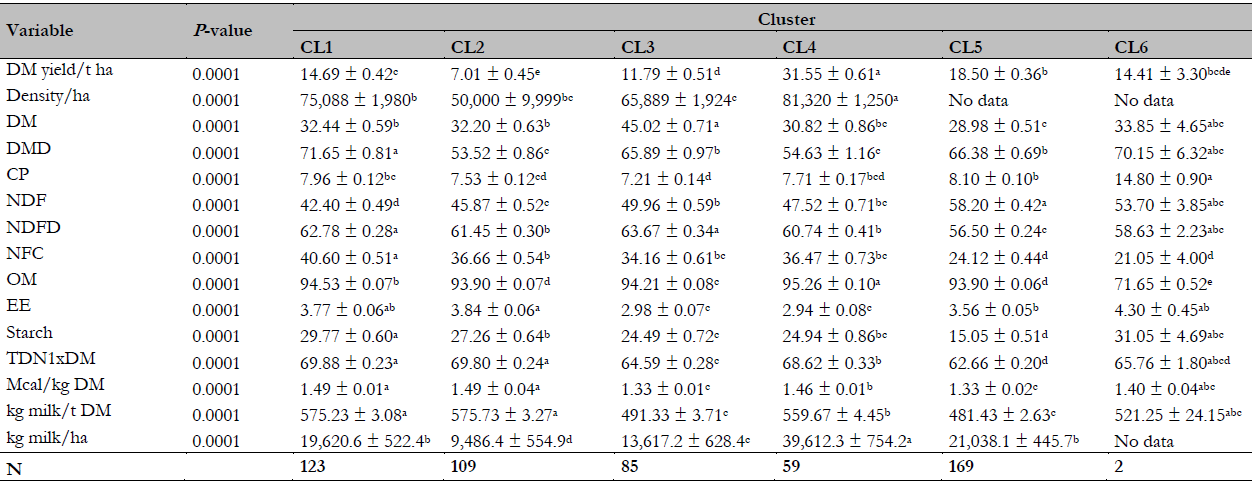
Source: Elaborated by the authors
Within the correlations of the analyzed variables shown in Table 7, the yield in tons of DM per ha has a positive correlation (P > 0.001) with the milk yield in kg per ha (r = 0.91). For NDF, we have a negative correlation: NFC (r = -0.95), starch (r = -0.85), NDFD (r = 0.53), TDN (r = -0.72), Mcal/kg DM (r = -0.69), and kg of milk/t DM (r = -0.71). NDFD has a positive correlation (P-value) with NFC (r = 0.55), TDN (r = 0.61), starch (r = 0.48), Mcal/kg DM (r = 0.42), and kg milk/t DM (r = 0.49). For NFC, there is a positive correlation with starch (r = 0.80) and a considerable positive correlation with TDN (r = 0.67), Mcal/kg DM (r = 0.63), and kg milk/t DM (r = 0.65). For starch, a positive correlation is observed with TDN (r = 0.65), Mcal/kg DM (r = 0.63), and kg milk/t DM (r = 0.64). TDN id positively correlated with Mcal/kg DM (r = 0.97) and kg milk/t DM (r = 0.98).
Density/ha has a positive correlation with DMD, which was an intermediate value (r = 0.42), attributed to greater competition for the space between plants, absorption of nutrients in the soil, and the uptake solar radiation for the photosynthesis process. This effect causes greater precocity (Sánchez et al., 2019) that will result in better DMD (Peña et al., 2002). Likewise, a positive correlation is noted with the variables CP, NDF, DM, and yield of DM/t, ha, but while positive, it was low. On the other hand, negative correlations are observed with the rest of the variables analyzed in this study. A lower NDFD has a negative influence on the behavior of eating and DM consumption (Grant & Ferraretto, 2018).
The correlation between forage yield/tons of DM and milk production/ha is significantly influenced by the population density, as a high population density increases the production of forage (kg/DM ha) (Table 7) (Guacapiña et al., 2018). A higher population density in the short season has small corn plants; as the population increases, the maturation and cutting date can be delayed, contributing to a decrease in the EE and starch content and an average NDF concentration (Guyader et al., 2018). With a large plant population, a higher forage yield of DM leads to higher milk production due to increased DMI (Ballard et al., 2001).
The correlation between DM and NDFD and starch was affected by the plant maturity stage, modifying the starch and NDFD content (Arriola et al., 2012). The maturity stages influenced NDF and NDFD concentrations of the whole plant. NDF content of the whole plant decreased with the maturity stage (Souza et al., 2011), showing that the DM content (> 35 g/100 g DM) mainly causes a decrease in the NFC, while at a very early stage of DM harvest (< 25 g/100 g DM), there is a relationship between starch and NDFD (Khan et al., 2015). The NDF correlations indicated that a higher NDF content commonly occurs with silage at very early maturity (< 25 g/100 g DM), resulting in lower starch content (Khan et al., 2015). Silage, the material with the most moisture, will generate a low concentration of NFC resulting from filtration by increased fluid production in the silo and a decrease in the NDFD (Guyader et al., 2018). Silage will have a low concentration of TDN, Mcal/kg DM, and lower DMI, resulting in lower milk yields (Khan et al., 2015).
Table 7. Correlation analysis of the variables related to corn silage (chemical composition) and milk yield (t/DM or kg/ha)
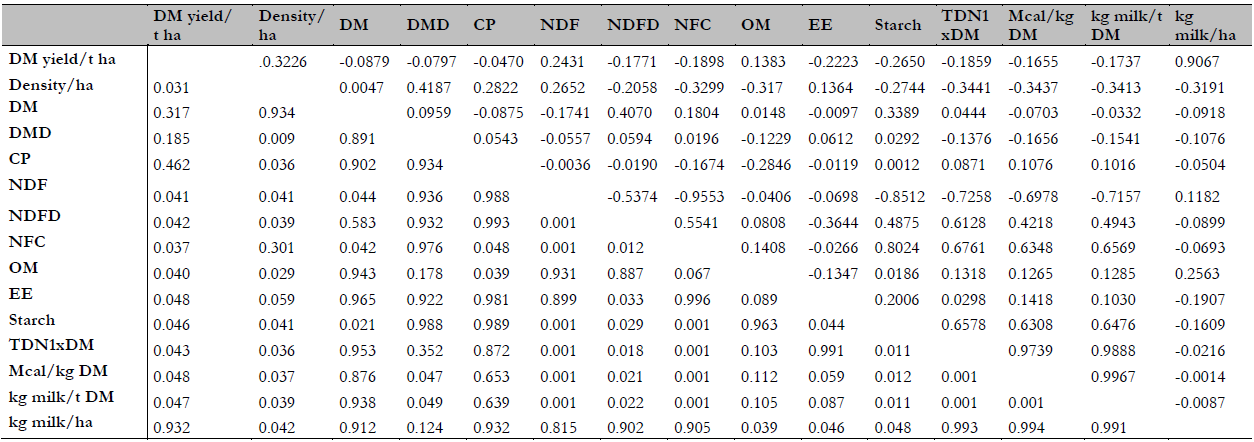
Source: Elaborated by the authors.
The NDF content was negatively correlated with digestibility (Salama, 2019); NDF affects DMI and milk production. Digestibility has a high impact on milk production. Forages with high NDF have higher NDF values (Combs, 2015); this NDF value was negatively correlated with NDF (Jayanegara et al., 2019). The strategy to improve the digestibility of NDF in silage is often related to reduced lignin or the concentration of indigestible NDF (Grant & Ferraretto, 2018). NDF content was negatively correlated with NCP (Jayanegara et al., 2019); an increase in NFC content decreases NDF content due to the dilution effect (Genero, 2015). NDFD decreased significantly with increasing DM content in corn silage from “very wet to dry”; however, in parallel to NDFD content, most of this decrease occurred when the DM content increased from very wet silages (Khan et al., 2015). A high NDFD of the whole plant occurs when it is harvested above 40 g/100 g DM, related to the effects of high digestibility by starch (Guyader et al., 2018); these changes reflect the transition from vegetative to reproductive growth in plants (Arriola et al., 2012). A high NDFD will generate high DMI and metabolizable energy (Vanegas & Codero, 2019), with high TDN values (Combs, 2015). The low TDN coefficient indicates its lower contribution to the energy available to cattle, which may be related to the negative effect of NDF, particularly the lignocellulose component on ruminal degradation and total digestibility of the tract (Jayanegara et al., 2019).
For the correlations given by NFC, Starch, TDN, and Mcal/kg DM, we can say that a high content of fermentable NFC from good quality corn silage will be in 27 and 32 g/100 g DM, with a high proportion of grain (Vanegas & Codero, 2019). The preceding is due to the process of starch formation, either by photosynthesis or in the reallocation of water-soluble carbohydrates from the stalk, which contributes significantly to the production of storable DM of NFC and starch (Khan et al., 2015). The concentrations of these components increased linearly with maturity, reflecting the transition from vegetative to reproductive growth in plants (Arriola et al., 2012). The high milk production observed by corn with high NDFD was mainly related to high DMI (Ferraretto & Shaver, 2015). Starch is the primary source of energy in corn silage and one of the primary sources of fermentable energy in the rumen (Khan et al., 2015). Starch is the main carbohydrate in NCF; its presence in the rations is increasingly high, given its high energy value and capacity to stimulate microbial population growth (Garrido, 2014). It will have high TDN values (Combs, 2015) and, therefore, a high Mcal/kg DM.
Conclusion
CL1 was characterized by a higher DMD, NDFD, NFC, and starch, allowing for a higher TDN1 x DM, energy concentration (Mcal/kg DM), and milk production (kg milk/t DM). In the same way, the characteristics of CL2 with higher EE content allow for a higher TDN1 x DM and energy concentration (Mcal/kg DM) to have higher milk production (kg milk/ha). The DM concentration increases in the whole plant because of maturity, affecting the starch content and NDFD; the DM content (> 35 g/100 g DM) mainly causes a decrease in the NDFD, while in a very early stage of DM harvest (< 25 g/100 g DM) a low ratio of starch: NDFD is present. NDF correlations indicate that a higher NDF content is commonly produced with silage at very early maturity (< 25 g/100 g DM), resulting in lower starch content. Silage material with high moisture content will generate a low NFC concentration resulting from silo filtration and a lower NDF.
This silage feed will have a low TDN, Mcal/kg DM concentration, and DMI, resulting in lower milk yields.















